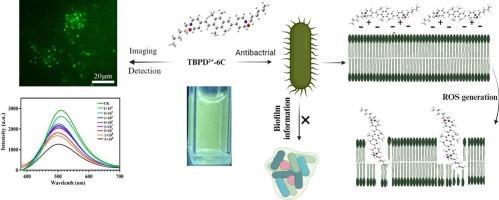阳离子 AIE 发光体原 TBPD2+-6C 作为潜在的细菌检测剂和植物细菌杀菌剂
IF 4.2
1区 农林科学
Q2 BIOCHEMISTRY & MOLECULAR BIOLOGY
引用次数: 0
摘要
植物细菌病原体的增加对全球主要粮食作物和经济作物的产量和质量构成了重大威胁。我们的研究引入了一种用于检测和消灭植物细菌的多功能阳离子 AIE 荧光探针。TBPD2+-6C 具有独特的聚集诱导发射特性,可通过荧光淬灭效应有效检测植物细菌,并可在绿色荧光通道下进行细菌成像。此外,TBPD2+-6C 还具有出色的抗菌效果,对黄单胞菌 oryzae pv. oryzicola(Xoc)、X. oryzae pv. oryzae(Xoo)、Pseudomonas syringae pv. actinidiae(Psa)和 X. axonopodis pv. citri(Xac)的 EC50 值分别为 0.27、3.86、0.47 和 11.5 μg/mL。针对 Xoc 的体内测试表明,TBPD2+-6C 比商用硫唑铜(TC)和双噻唑(BT)具有更好的活性。此外,对抗菌机制的研究还发现,阳离子化合物能有效地融入细菌膜,破坏膜结构,引发 ROS 积累,抑制生物膜的形成。总之,开发多功能、广谱抗菌系统分子设计,用于快速实时检测、成像和消除耐药微生物,可在抗击病原体方面发挥重要作用。本文章由计算机程序翻译,如有差异,请以英文原文为准。

A cationic AIE luminutesogen TBPD2+-6C as a potential bacterial detection agent and bactericide for plants bacterium
The rise of plant bacterial pathogens poses a significant threat to the yield and quality of essential food crops and cash crops globally. Our research introduced a versatile cationic AIE fluorescent probe for detecting and eliminating plant bacteria. With its unique aggregation-induced emission property, TBPD2+-6C can effectively detect plant bacteria by causing a fluorescence quenching effect and enables bacterial imaging under green fluorescence channels. Additionally, TBPD2+-6C demonstrates outstanding antibacterial effectiveness, with EC50 values of 0.27, 3.86, 0.47, and 11.5 μg/mL against Xanthomonas oryzae pv. oryzicola (Xoc), X. oryzae pv. oryzae (Xoo), Pseudomonas syringae pv. actinidiae (Psa), and X. axonopodis pv. citri (Xac), respectively. In vivo testing against Xoc revealed that TBPD2+-6C showed better activity than commercial thiodiazole copper (TC) and bismerthiazol (BT). Furthermore, the investigation into the antibacterial mechanism revealed that the cationic compound can effectively integrate into the bacterial membrane, disrupt the membrane structure, trigger ROS accumulation, and inhibit biofilm formation. In conclusion, the development of multifunctional, broad-spectrum antimicrobial system molecular designs for rapid real-time detection, imaging, and elimination of resistant microbes could play a vital role in combating pathogens.
求助全文
通过发布文献求助,成功后即可免费获取论文全文。
去求助
来源期刊
CiteScore
7.00
自引率
8.50%
发文量
238
审稿时长
4.2 months
期刊介绍:
Pesticide Biochemistry and Physiology publishes original scientific articles pertaining to the mode of action of plant protection agents such as insecticides, fungicides, herbicides, and similar compounds, including nonlethal pest control agents, biosynthesis of pheromones, hormones, and plant resistance agents. Manuscripts may include a biochemical, physiological, or molecular study for an understanding of comparative toxicology or selective toxicity of both target and nontarget organisms. Particular interest will be given to studies on the molecular biology of pest control, toxicology, and pesticide resistance.
Research Areas Emphasized Include the Biochemistry and Physiology of:
• Comparative toxicity
• Mode of action
• Pathophysiology
• Plant growth regulators
• Resistance
• Other effects of pesticides on both parasites and hosts.

 求助内容:
求助内容: 应助结果提醒方式:
应助结果提醒方式:


